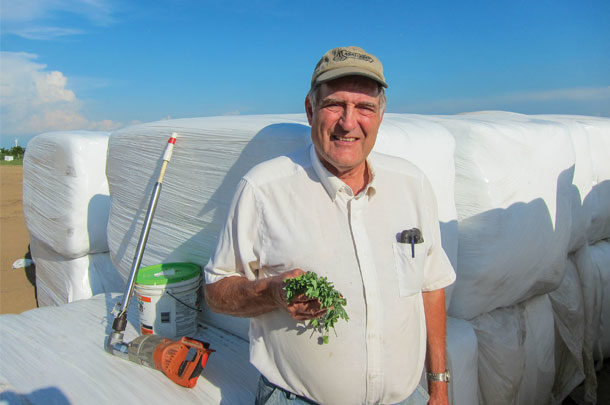Guither knows a thing or two about growing quality baleage, and if his customers (the ones on four legs) had anything to say, they’d probably heartily agree.
Kendall and his wife, Katherine, grow 450 acres of hay crops and 200 acres of corn on their farm in northwestern Illinois. His family has farmed in the region for more than 150 years and, while his roots are deep into farming, growing baleage is a relatively new endeavor for the operation.
Early in his farming career, he was looking for a way to expand his operation, but with humidity often 40% to 60% in the region, he knew growing more dry hay probably wasn’t the answer. In 1996, while at a forage expo, Guither attended a seminar where they demonstrated wrapping bales to make baleage. This process caught his attention, and he figured he’d give it a shot. That winter he bought a new cutter, a bale wrapper and midsized square silage baler. The rest is history.
Guither says, “Going into it, I didn’t understand the real potential of a baleage system. At first, I was looking at it as just a backup for the ongoing weather issues associated with raising dry hay. But it wasn’t long until I saw the real value of baleage, and today we put up 95 to 100 percent of our crop as baleage.”
Focus on quality
Since the very beginning, Guither has made the focus of his operation quality production. He says, “Quality is key. Your hay will never be better quality than the moment you cut it. It can’t improve after you cut it, but it can and does deteriorate. My job is to maintain that quality as best I can through the baling and wrapping stages.”
Quality is what he has become known for, as his customers and fellow hay farmers across the Midwest can attest. He jokes that the customer which really matters is the one on four legs. Guither says, “The cows and goats are usually the ones that prove the value of my baleage to the dairy farmer.”
He says, “Some guys will complain about the moisture in baleage, saying ‘We don’t want to pay to truck all that water.’ I say, ‘Let your animal decide if you should pay to truck the water.’ People will begin to pay for quality baleage when they see how their animals respond to it. And, boy, will their animals respond. My customers can see a jump in milk production in their cows, and their goats’ production could increase 1 to 2 pounds a day.”
How does he grow this quality feed? It’s all about paying attention to the details and having the right mentality going into the process.
The mentality of baleage
Guither says, “If you are thinking about growing baleage, you have to approach it with the right mentality. So many people think of it as a backup plan. The day you cut your hay, decide on baleage or dry hay. It’s not something you decide after you have cut hay and see rain in the forecast. It’s not a “wait and see” and use baleage as a rescue; by that time, it can be too dry and not ferment properly. That’s a recipe for a low-quality product.”
And a low-quality product is what Guither avoids at all cost. He jokes, “All wet feeds end in ‘a-g-e.’ There is corn silage, haylage, and then there is baleage. When it comes to baleage, there is the good stuff, but there is also fail-age and worst of all, garb-age.” Once Guither approached baleage with the mentality that it was his end goal, not a Plan B, he was able to perfect his skills. Today, his baleage often reaches 80% to 83% digestibility – far, far from garbage.
He says, “After my hay is cut, my job becomes moisture management, which is true for both dry hay and baleage. However, the benefit of baleage is that you have a wider window of bale time. I am looking for moisture anywhere above 40 percent and below 65 percent, ideally 45 percent to 55 percent. Generally, I can have my hay cut, baled and wrapped within 48 hours. That takes so much of the stress out of the equation. Without that stress to contend with, making hay is plain fun.”
Mentorship as a hallmark
Growing baleage and sharing what he learns is a way of life for Guither. It may be a phone call with a farmer in Fargo or an email correspondence with university extension in Kansas. Often it’s a conversation at the World Dairy Expo with a potential client or a fellow farmer – swapping stories and sharing advice on quality forage production. Guither has become known for his ability to grow quality forage but also his willingness to share what he knows about the business.
He says, “Agri-King was the first to really notice what I was doing and the quality of product I was producing. They started asking me to speak at their sales meetings and with their growers. Opportunities grew from there. As I travel across the county, I love to help farmers learn about baleage, understand the benefits to their animals and the potential it could have on their operation.”
Guither has also served his industry though a 30-plus-year membership in the Illinois Forage and Grassland Council. He served six years as an officer. As many could attest, Kendall Guither makes mentorship a hallmark of his operation.
When asked what he was most proud of on his operation, he simply says, “Doing baleage right.” When prompted, he adds, “I think it’s just fun delivering a load of baleage to a customer and seeing how their animals react to it. It’s fun to produce a great product. It’s fun to please my customer. It’s fun to talk to people about what I do. It’s fun to mentor and share my knowledge.” And, with a little hesitation, he says, “What I really am proud of, and it may sound like a brag, but in the 22 years I have grown baleage, I have yet to chop any back onto the field. I always get it out.” There are probably few hay producers that could challenge that field record.
It looks like Kendall Guither is doing baleage right. ![]()
PHOTO: Kendall Guither displays his award-winning baleage from his farm in northwest Illinois. Photo provided by Kendall Guither.
Erica Louder is a freelance writer based in Idaho.












